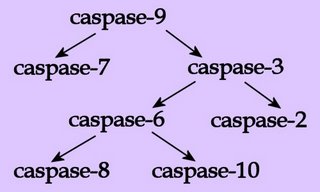amino acids
Commonly called the 'building-blocks of proteins', amino acids comprise a carboxylic acid group (COOH), an attached side chain, and an amino group (NH2). The general structure of alpha amino acids is COOH-HCR-NH2, where R represents a side-chain specific to each amino acid, and the carboxyl and amino acids are attached to the same carbon atom.
Amino acids form peptide and protein polymers. metastream - amino acid : animation - peptide : image - primary structure protein : animation - protein : Over 90 amino acids are found in nature, while only 20 proteinogenic, standard amino acids are coded for by DNA. Of interest, 13 of the 21 amino acids found in cellular protein were generated in the Miller-Urey experiment, glycine being the commonest.
Several of the proteinogenic amino acids are termed ‘essential’ because they cannot be synthesized by the body’s metabolism and must be ingested in the diet. For adult humans isoleucine, leucine, lysine, methionine, phenylalanine, threonine, tryptophan, and valine are essential, while children also require dietary histidine and arginine. Two other amino acids, selenocysteine and pyrrolysine, are sometimes incorporated during translation from RNA to protein.
In addition to their roles as substrates in peptide and protein synthesis, amino acids have other biologically important functions. Glycine, and glutamate, are both employed as neurotransmitters
Non-standard amino acids are produced by post-translation modification, and some non-standard amino acids are produced only by plants and micro-organisms. Many amino acids are modified in the synthesis of other bio-active molecules: tryptophan is a precursor of the neurotransmitters serotonin, and glycine is one of the reactants in the synthesis of porphyrins such as heme. Numerous non-standard amino acids are also biologically important: GABA is another neurotransmitters, carnitine is employed in lipid transport within cells. Others non-standard amino acids include citrulline, homocysteine, hydroxyproline, hydroxylysine, ornithine, and sarcosine.
Virtual Cell Textbook - Biomolecules : Cell Textbook - Cell Biology : | 0 Guide-Glossary

Amino acids form peptide and protein polymers. metastream - amino acid : animation - peptide : image - primary structure protein : animation - protein : Over 90 amino acids are found in nature, while only 20 proteinogenic, standard amino acids are coded for by DNA. Of interest, 13 of the 21 amino acids found in cellular protein were generated in the Miller-Urey experiment, glycine being the commonest.
Several of the proteinogenic amino acids are termed ‘essential’ because they cannot be synthesized by the body’s metabolism and must be ingested in the diet. For adult humans isoleucine, leucine, lysine, methionine, phenylalanine, threonine, tryptophan, and valine are essential, while children also require dietary histidine and arginine. Two other amino acids, selenocysteine and pyrrolysine, are sometimes incorporated during translation from RNA to protein.
In addition to their roles as substrates in peptide and protein synthesis, amino acids have other biologically important functions. Glycine, and glutamate, are both employed as neurotransmitters
Non-standard amino acids are produced by post-translation modification, and some non-standard amino acids are produced only by plants and micro-organisms. Many amino acids are modified in the synthesis of other bio-active molecules: tryptophan is a precursor of the neurotransmitters serotonin, and glycine is one of the reactants in the synthesis of porphyrins such as heme. Numerous non-standard amino acids are also biologically important: GABA is another neurotransmitters, carnitine is employed in lipid transport within cells. Others non-standard amino acids include citrulline, homocysteine, hydroxyproline, hydroxylysine, ornithine, and sarcosine.
Virtual Cell Textbook - Biomolecules : Cell Textbook - Cell Biology : | 0 Guide-Glossary









































